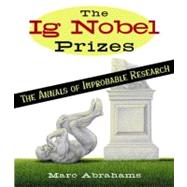
Note: Supplemental materials are not guaranteed with Rental or Used book purchases.
Purchase Benefits
What is included with this book?
| Introduction | p. 1 |
| What's an Ig? | p. 2 |
| How It Began, Briefly | p. 3 |
| How the Winners Are Chosen | p. 4 |
| The Ceremony | p. 5 |
| Controversy | p. 9 |
| How to Read This Book | p. 12 |
| Medical Breakthroughs | p. 15 |
| Failure of Electric Shock Treatment for Rattlesnake Envenomation | p. 16 |
| Nose Picking in Adolescents | p. 19 |
| Elevator Music Prevents the Common Cold | p. 23 |
| Psychology and Intelligence | p. 27 |
| A Forbidding Experiment: Spitting, Chewing Gum, and Pigeons | p. 28 |
| Ignorance Is Bliss | p. 31 |
| Economics | p. 35 |
| Squeezing Orange County/Bringing Down Barings | p. 36 |
| The Good Lloyd's Shepherds Insure Disaster | p. 40 |
| Dying to Save Taxes | p. 43 |
| Enron--and Then Some (and Then None) | p. 46 |
| Peace--Diplomacy and Persuasion | p. 51 |
| The Levitating Crime Fighters | p. 52 |
| Daryl Gates, the Gandhi of Los Angeles | p. 55 |
| Stalin World | p. 59 |
| Peaceful Ejaculations and Explosions | p. 63 |
| Booming Voices of Britain | p. 64 |
| Father of the Bomb | p. 67 |
| Pacific Kaboom | p. 70 |
| Love and/or Reproduction | p. 73 |
| The Compulsive Biochemistry of Love | p. 74 |
| High-Velocity Birth | p. 78 |
| Taking Fatherhood in Hand | p. 82 |
| Insert Here | p. 86 |
| Height, Penile Length, and Foot Size | p. 90 |
| Discoveries--Basic Science | p. 93 |
| The Happiness of Clams | p. 94 |
| Cold Fusion in Chickens | p. 97 |
| Mini-Dinosaurs, Mini-Princesses | p. 101 |
| The Remembrance of Water Passed | p. 106 |
| Discoveries--Things That Rise or Fall | p. 111 |
| Injuries Due to Falling Coconuts | p. 112 |
| The Fall of Buttered Toast | p. 116 |
| The Collapse of Toilets in Glasgow | p. 120 |
| Levitating Frogs | p. 124 |
| Troy and the Grizzly Bear | p. 127 |
| Troy and the Grizzly Bear | p. 128 |
| Inventions | p. 133 |
| The Most Inventive Salesman | p. 134 |
| The Kitty and the Keyboard | p. 138 |
| Patenting the Wheel | p. 141 |
| Hellish Technicalities | p. 145 |
| Who Is Going to Hell | p. 146 |
| Mikhail Gorbachev Is the Antichrist | p. 149 |
| Scents and Sensibility | p. 155 |
| The Self-Perfuming Business Suit | p. 156 |
| Filter-Equipped Underwear | p. 159 |
| Food for Thought | p. 163 |
| Extremely Instant Barbecue | p. 164 |
| Sogginess at Breakfast | p. 167 |
| The Effects of Ale, Garlic, and Soured Cream on the Appetite of Leeches | p. 170 |
| No Need for Food | p. 174 |
| How to Make a Cup of Tea, Officially | p. 178 |
| The Sociology of Canadian Donut Shops | p. 183 |
| The Optimal Way to Dunk a Biscuit | p. 186 |
| Education | p. 191 |
| Banning the Beaker | p. 192 |
| Deepak Chopra | p. 195 |
| Dan Quayle | p. 199 |
| Literature | p. 201 |
| 976 Coauthors in Search of a Title | p. 202 |
| The Father of Junk E-mail | p. 204 |
| Appendices | p. 209 |
| Year-by-Year List of Winners | p. 210 |
| How to Nominate Someone | p. 229 |
| The Web Site | p. 231 |
| About the Annals of Improbable Research | p. 232 |
| Acknowledgments | p. 234 |
| Index | p. 237 |
| Table of Contents provided by Ingram. All Rights Reserved. |
The New copy of this book will include any supplemental materials advertised. Please check the title of the book to determine if it should include any access cards, study guides, lab manuals, CDs, etc.
The Used, Rental and eBook copies of this book are not guaranteed to include any supplemental materials. Typically, only the book itself is included. This is true even if the title states it includes any access cards, study guides, lab manuals, CDs, etc.